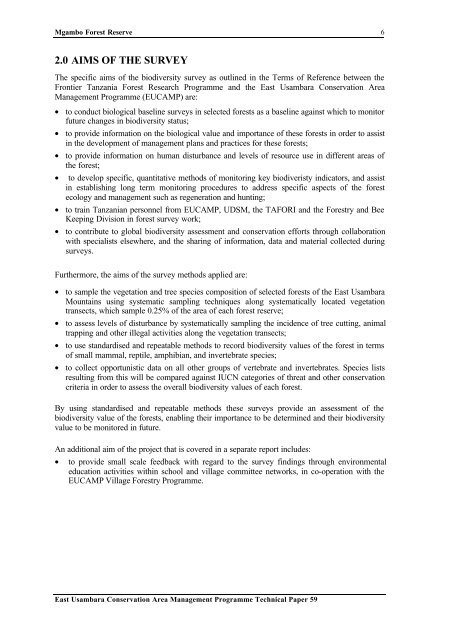Mgambo Forest Reserve: A biodiversity survey. - Eastern Arc ...
Mgambo Forest Reserve: A biodiversity survey. - Eastern Arc ...
Mgambo Forest Reserve: A biodiversity survey. - Eastern Arc ...
Create successful ePaper yourself
Turn your PDF publications into a flip-book with our unique Google optimized e-Paper software.
<strong>Mgambo</strong> <strong>Forest</strong> <strong>Reserve</strong><br />
6<br />
2.0 AIMS OF THE SURVEY<br />
The specific aims of the <strong>biodiversity</strong> <strong>survey</strong> as outlined in the Terms of Reference between the<br />
Frontier Tanzania <strong>Forest</strong> Research Programme and the East Usambara Conservation Area<br />
Management Programme (EUCAMP) are:<br />
• to conduct biological baseline <strong>survey</strong>s in selected forests as a baseline against which to monitor<br />
future changes in <strong>biodiversity</strong> status;<br />
• to provide information on the biological value and importance of these forests in order to assist<br />
in the development of management plans and practices for these forests;<br />
• to provide information on human disturbance and levels of resource use in different areas of<br />
the forest;<br />
• to develop specific, quantitative methods of monitoring key biodiveristy indicators, and assist<br />
in establishing long term monitoring procedures to address specific aspects of the forest<br />
ecology and management such as regeneration and hunting;<br />
• to train Tanzanian personnel from EUCAMP, UDSM, the TAFORI and the <strong>Forest</strong>ry and Bee<br />
Keeping Division in forest <strong>survey</strong> work;<br />
• to contribute to global <strong>biodiversity</strong> assessment and conservation efforts through collaboration<br />
with specialists elsewhere, and the sharing of information, data and material collected during<br />
<strong>survey</strong>s.<br />
Furthermore, the aims of the <strong>survey</strong> methods applied are:<br />
• to sample the vegetation and tree species composition of selected forests of the East Usambara<br />
Mountains using systematic sampling techniques along systematically located vegetation<br />
transects, which sample 0.25% of the area of each forest reserve;<br />
• to assess levels of disturbance by systematically sampling the incidence of tree cutting, animal<br />
trapping and other illegal activities along the vegetation transects;<br />
• to use standardised and repeatable methods to record <strong>biodiversity</strong> values of the forest in terms<br />
of small mammal, reptile, amphibian, and invertebrate species;<br />
• to collect opportunistic data on all other groups of vertebrate and invertebrates. Species lists<br />
resulting from this will be compared against IUCN categories of threat and other conservation<br />
criteria in order to assess the overall <strong>biodiversity</strong> values of each forest.<br />
By using standardised and repeatable methods these <strong>survey</strong>s provide an assessment of the<br />
<strong>biodiversity</strong> value of the forests, enabling their importance to be determined and their <strong>biodiversity</strong><br />
value to be monitored in future.<br />
An additional aim of the project that is covered in a separate report includes:<br />
• to provide small scale feedback with regard to the <strong>survey</strong> findings through environmental<br />
education activities within school and village committee networks, in co-operation with the<br />
EUCAMP Village <strong>Forest</strong>ry Programme.<br />
East Usambara Conservation Area Management Programme Technical Paper 59
















